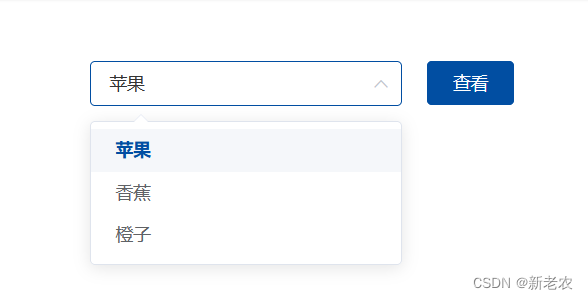1.Bson的类型
bson对象是键值对对象,bson是JSON的二进制格式。go操作mongoDB数据库的时候经常使用bson键值对作为筛选条件。
D:一个BSON文档,这种类型应该在顺序重要的情况下使用。 每一对键值对都包含一个大括号,bson.D{{key,value},{key,value}},中间用逗号连接key,value。
M:一个无序的map,它和D是一样的,只是它不保持顺序。 每一对键值对不使用大括号,bson.M{key:value},中间用 冒号key:value 进行连接。
A:一个BSON数组,当使用“$and”,“$or”等要使用数组。
package bson // import "go.mongodb.org/mongo-driver/bson"
import (
"go.mongodb.org/mongo-driver/bson/primitive"
)
// D is an ordered representation of a BSON document. This type should be used when the order of the elements matters,
// such as MongoDB command documents. If the order of the elements does not matter, an M should be used instead.
// Example usage:
// bson.D{{"foo", "bar"}, {"hello", "world"}, {"pi", 3.14159}}
type D = primitive.D
// E represents a BSON element for a D. It is usually used inside a D.
type E = primitive.E
// M is an unordered representation of a BSON document. This type should be used when the order of the elements does not
// Example usage:
//
// bson.M{"foo": "bar", "hello": "world", "pi": 3.14159}
type M = primitive.M
// An A is an ordered representation of a BSON array.
// Example usage:
// bson.A{"bar", "world", 3.14159, bson.D{{"qux", 12345}}}
type A = primitive.A(1)bson.D
bson.D是一种有序的键值对,D(Document)格式代表了一个BSON文档。D包含了一个E切片,
type D []E每一对键值对都需要用大括号来连接,bson.D{{key,value},{key,value}…},键和值之间使用逗号连接,比如:
bson.D{{"foo", "bar"}, {"hello", "world"}, {"pi", 3.14159}}(2)bson.E
bson.D有序键值对的其中一个元素。一个bson.D由多个bson.E构成。
// E represents a BSON element for a D. It is usually used inside a D.
type E struct {
Key string
Value interface{}
}
bson.D{
bson.E{Key: "name", Value: "zhangsan"},
bson.E{Key: "age", Value: 19},
}(3)bson.M
bson.M{"foo": "bar", "hello": "world", "pi": 3.14159}(4)bson.A
bson.A是一个bson数组,当使用“$and”,等等,会使用数组。比如:
a := bson.A{
"bar",
"cars",
bson.M{
"name": "zhangsan",
"age": 18,
},
bson.E{
Key: "address",
Value: "China",
},
bson.D{
{"cinder", "kingsoft"},
{"glance", "kingsoft"},
},
}bson.D和bson.M区别
①bson.D是有序的,bson.M是无序的。
③bson.M键值对使用:链接,bson.D键值对使用逗号,连接
2.举例
func bsonTestM() {
docs := bson.M{
"name": "Alice",
"age": 18,
// addr是一个无序的键值对
"addr": bson.M{
"city": "beijing",
"country": "China",
},
}
// 序列化字节数组 func Marshal(val interface{}) ([]byte, error) {
data, err := bson.Marshal(docs)
if err != nil {
panic(err)
}
fmt.Println("输出序列化的data内容:", data)
var result bson.M
// 方便将字节[]byte映射到结果集中。
err = bson.Unmarshal(data, &result)
if err != nil {
panic(err)
}
fmt.Println("输出反序列化后的内容:", result)
fmt.Printf("bson.M类型为%T", bson.M{})
}
// 有序的键值对对象
func bsonTestD() {
docs := bson.D{
{"name", "zhangsan"},
{"age", 18},
}
bytes, err := bson.Marshal(docs)
if err != nil {
panic(err)
}
var result bson.D
// 为什么使用&result
// 因为Unmarshal函数需要修改目标对象的值,而不仅仅是复制数据。通过传递指针,函数可以直接在目标对象的内存地址上进行操作,
// 从而避免了对整个对象进行复制,节省了内存和处理时间。
//另外,通过传递指针,可以确保Unmarshal函数可以正确地更新目标对象的值,而不是创建一个新的对象。
/*
总之,&result,其实就是为了可以直接在目标对象的内存地址进行操作,避免对整个对象的复制,节省了内存和处理时间。
*/
err = bson.Unmarshal(bytes, &result)
if err != nil {
panic(err)
}
fmt.Println(result)
}
func testBsonA() {
a := bson.A{
"bar",
"cars",
bson.M{
"name": "zhangsan",
"age": 18,
},
bson.E{
Key: "address",
Value: "China",
},
bson.D{
{"cinder", "cinder"},
{"glance", "demo"},
},
}
fmt.Println(a)
}其实用的比较多的是在go操作mongoDB的时候,因为mongoDB是键值对的数据库,bson文档可以作为filter过滤条件,这个用的多一些。
欢迎关注公众号:天天说编程
原文地址:https://blog.csdn.net/Sunshineoe/article/details/133668839
本文来自互联网用户投稿,该文观点仅代表作者本人,不代表本站立场。本站仅提供信息存储空间服务,不拥有所有权,不承担相关法律责任。
如若转载,请注明出处:http://www.7code.cn/show_16581.html
如若内容造成侵权/违法违规/事实不符,请联系代码007邮箱:suwngjj01@126.com进行投诉反馈,一经查实,立即删除!




